DACF Home → Bureaus & Programs → Maine Natural Areas Program → Communities, Plants, and Animals → Invasive Plants → Common Buckthorn
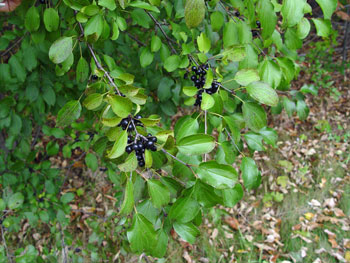 Common buckthorn stem with fruit
Common buckthorn stem with fruit
Common Buckthorn
Rhamnus cathartica
2019 Status in Maine: Widespread. Severely Invasive.
Description: Perennial, deciduous shrub or small tree, often multi-stemmed, can be single-trunked, to ~25' tall. Despite name, lacks thorns; has small spines (up to 7⁄8" but usually < ½") at very end of most twigs.
Leaves: Simple, sub-opposite, some more nearly alternate or opposite, elliptical to almost round, toothed, with arching leaf veins, pointed tip, 1-3" long. Flowers: Small, white-green, 4-petaled, in clusters at leaf bases along stems, appear in ~June in Maine. Fruit: Round, ¼ - ½" wide, mature from green to a glossy black color in late summer. Bark: Mature plants have horizontal, lighter-colored lenticels on brownish-gray bark. Larger plants have orange inner bark.
Native range: Europe and Asia. How arrived in U.S.: As an ornamental; wind break and hedge plant.
Reproduction: By seed. Plants are usually dioecious; males do not produce fruit. Fruits are eaten by birds, mice, and deer. Seeds viable for 2-6 years.
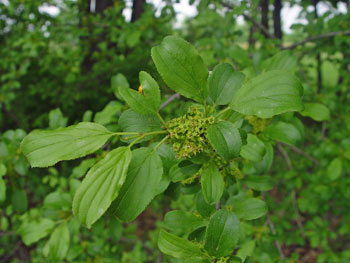 Common buckthorn stem with flowers
Common buckthorn stem with flowers
Habitat: Forests, forest edges, old fields, open areas. Shade-tolerant; will germinate, grow, and reproduce under full canopy. Tolerant of moist to well-drained soil.
Similar native species: Alder-leaved buckthorn (Rhamnus alnifolia) has larger leaves that are opposite along the stem, 5-petaled flowers, and is a low shrub (<5') of wetlands. Cherries (Prunus spp.) have lenticels but scratched bark or twig has characteristic bitter almond smell and leaves are consistently alternate. Winterberry holly (Ilex verticillata) has alternate leaves, bright red fruits, and prefers wet soils. None have orange inner bark.
Similar non-native species: Glossy buckthorn (Frangula alnus) leaves are entire, twig ends have no spines, can have both red and black fruit at once, and lacks orange inner bark. Apples (Malus spp.) have alternate leaves and leaf venation that is not as pronounced.
Documented Ecological Impacts
- Common buckthorn alters native plant community composition and structure, and the dense shade can interfere with establishment of native plants. (Zouhar, Kris. 2011. Rhamnus cathartica, R. davurica. In: Fire Effects Information System. U.S. Department of Agriculture, Forest Service)
- Common buckthorn alters ecosystem processes, including decomposition and nitrogen and carbon cycling. Leaf litter has high nitrogen levels and decomposes rapidly. This nitrogen is not available to other plants but is an attractive food source for non-native invasive earthworms, which further reduce the leaf litter layer and affect nutrient cycling. The bare soil conditions under common buckthorn are ideal for its own seed germination.(Knight, KS, et al. 2007. Ecology and ecosystem impacts of common buckthorn (Rhamnus cathartica): a review. Biol Invasions 9:925–937)
- A compound in common buckthorn is associated with malformation and mortality in amphibian species. (Sacerdote, A.B. and R. B. King. 2014. Direct effects of an invasive European buckthorn metabolite on embryo survival and development in Xenopus laevis and Pseudacris triseriata. Journal of Herpetology 48:51-58)
- The Maine Nautral Areas Program has documented common buckthorn invading rare floodplain forest natural communities in Maine, a top concern for conservation of biodiversity.
Fact Sheets and Identification Links
- Vermont Fact Sheet and Species Spotlight for Common Buckthorn
- Red Wing, Minnesota, Identification Video (3:45)
- Michigan DNR Best Control Practices for Common Buckthorn
- Go Botany page for Rhamnus cathartica
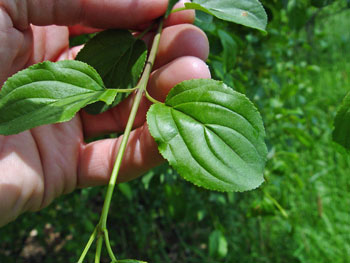 Common buckthorn stem showing leaf stipules
Common buckthorn stem showing leaf stipules
Control Methods
Small plants and seedlings may be pulled up by the roots when soil is moist; larger plants can be cut, but re-sprouting will occur.* Persistent cutting or mowing multiple times during the growing season over several years may kill the plant, but diligence is required (at least 3x/yr for 3 yrs is suggested). Mowing can prevent seedlings from establishing. Common buckthorn keeps its leaves late into the fall after native plants have dropped theirs. Foliar applications of glyphosate† aare very effective during this period. Herbicides can also be applied as cut-stump applications (glyphosate or triclopyr solution applied immediately after cutting except in early spring), or basal bark application (for stems <6" diameter, triclopyr ester in bark oil).
* Correctly dispose of all plant parts↵ † Follow all label directions when using herbicides↵Control Technique Video Demonstrations
- Coon Rapids, Minnesota (6:29), hand pulling, weed wrench, stump cut and herbicide
- Ontario (5:00), lever/wrench, girdling, proper disposal and restoration
- Forest Restorations, Minnesota (2:30), hand tools: lever/wrench
Please email invasives.mnap@maine.gov if you have questions about invasive species in Maine
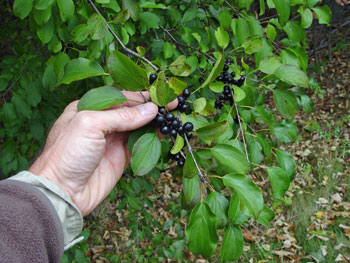 Common buckthorn fruit
Common buckthorn fruit
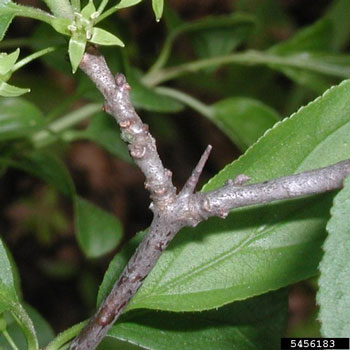 Terminal thorn-like spine on common buckthorn, Leslie J. Mehrhoff, University of Connecticut, Bugwood.org
Terminal thorn-like spine on common buckthorn, Leslie J. Mehrhoff, University of Connecticut, Bugwood.org
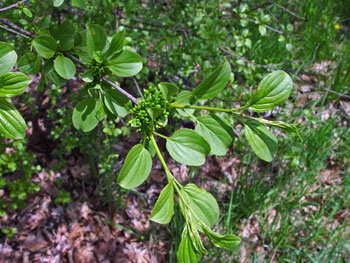 Common buckthorn branch
Common buckthorn branch